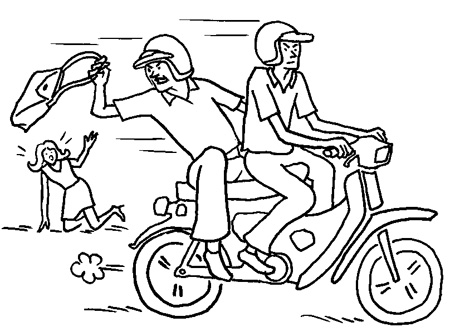Difference between revisions of "Security issue: Robbery"
m (Text replace - "Attributing circumstances" to "Contributing circumstances") |
|||
| Line 19: | Line 19: | ||
* robbery of migrant labourers. |
* robbery of migrant labourers. |
||
== |
== Contributing circumstances == |
||
* Robbery performed in the neighbourhood |
* Robbery performed in the neighbourhood |
||
* Alcohol |
* Alcohol |
||
Revision as of 12:53, 4 February 2013
Robbery is the crime of taking or attempting to take something of value by force or threat of force or by putting the victim in fear. It is used her exclusively for acts committed to individual persons. For the forceful theft from commercial venues, see raid.
Contents
Description
In the context of urban planning, robbery is most relevant if performed in the public space. This form of robbery, called street robbery has the following five characteristics[1]:
- the offender targets a victim;
- the victim is a stranger to the offender;
- the offender attempts or completes a theft of cash or property;
- the offender uses force or the threat of force against the victim; and
- the offence occurs in a public or semi-public place, such as on a street, in an alley, in a parking garage, in a public park, on or near public transportation, or in a shared apartment hallway.
Mark that a robbery need not involve the use of a weapon or injuries of the victim.
Several subtypes of street robbery exist that vary in frequency depending on local circumstances. Among the better known are:
- purse-snatching (referred to as "snatch theft");
- robbery at automated teller machines;
- robbery of drunken bar patrons; robbery of students (e.g., middle- and high-school students and college students);
- robbery of passengers near public transportation systems; and
- robbery of migrant labourers.
Contributing circumstances
- Robbery performed in the neighbourhood
- Alcohol
- Distraction
- Presence of valuables
- Presence of black market
- Hiding spots
- Flight paths
- Special circumstances (holidays, road work, etc.)
Socio-economic circumstances
Although there is no real scientific consensus with respect to the causal relationship between the socio-economic background and property crime like robberies, Australian research, for example, illustrates that long term unemployment amongst young male adolescents has a substantial effect on property crime rates[2].
Enthorf and Spengler(2002)[3] find that planning-intense offences like breaking and entering, robbery and violence respond relatively slow to changes in the socio-economic conditions compared to other types of crime like drug and alcohol abuse and violent crime. According to the authors, this may reflect that in a first response to unfortunate social and economic developments some of the affected might become attracted to alcohol and drug abuse, which in a later phase has to be financed with criminal activities by committing property crimes like breaking and entering.
Impacts
- Psychological distress, including fear, anger and depression[4]
- social effects
- Physical harm
- (Personal) financial loss
- Decrease in perceived security
- Increased personal vulnerability
Economic impact
Robbery leads to considerable costs in both a direct (primary) and a indirect (secondary) way[5]. Direct costs of robbery come in the form of:
- Preventive costs in anticipation of robbery (e.g. security measures, insurance);
- Material and immaterial costs as a consequence of robbery (e.g. physical damage, repairs, medical costs, mental harm); and
- Responsive costs to robbery (e.g. the costs of detection and prevention, persecution, support trial, etc.).
In addition, the secondary economic impact of criminal offences has to be considered. Crime not only leads to financial or physical damage and prevention costs, but also indirectly influences the local/regional and national economy of a country. According to Detotto and Otranto [6],“crime acts like a tax on the entire economy: it discourages domestic and foreign direct investments[7]. On a more local and regional level, economists define economic impact on business, property value, tourism and quality of life (social capital).
Measures
Many strategies exist to reduce the risk of street robbery. Of these, most are actions that are taken just before or after specific incidents. These are therefore not suited to be integrated in to the planning of urban environment, as this generally precedes incidents by a long time. Measures[1] that are effective against street robbery and can be taken (or at least influenced) by the urban planner, are:
- Providing safe transportation
- Providing safe routes during construction
- Reducing intoxication in high-risk areas
- Removing hiding spots
- Increasing lighting at high-risk sites
- Surveillance (electronic or other)
- Increasing pedestrian density near risky places
- Installing emergency call stations
Footnotes and references
- ↑ 1.0 1.1 http://www.popcenter.org/problems/street_robbery
- ↑ See, e.g.: Chapman, B., D Weatherburn, C.A. Kapuscinski, M. Chilvers and S. Roussel (2002). Unemployment duration, schooling and property crime. CEPR Working paper
- ↑ Entorf, H., H. Spengler (2002). Crime in Europe; Causes and Consequences. Springer-Verlag Berlin
- ↑ http://irv.sagepub.com/content/14/2/175
- ↑ Primary economic impact (or direct effects) are generally defined as the initial, immediate economic output generated by a specific cause (in this case a criminal offence). Secondary economic impact (or indirect effects) are generated each time a subsequent transaction is made, for example, the impact of crime on the real estate value in the neighbourhood.
- ↑ Detotto,C. and E. Otranto (2010). Does crime affect Economic growth? KYKLOS, Vol.63–August 2010-No.3, 330-345.
- ↑ Foreign direct investment (FDI) is a direct investment by a business or enterprise in a foreign economy.
